Few examples of early Chinese sculpture are more widely known than are the two Buddhist pedestals recently acquired by the University Museum. Among European authorities who have thought them worthy of particular notice have been Bushell1 and Chavannes,2 while in China itself rubbings of the designs covering their sides are in the hands of every collector.
The practice which grew up in China during the early centuries of our era of carving scenes of various sorts upon slabs of stone was undoubtedly inspired by the mural painting of the day. It is this fact that confers upon these two pedestals one of their chief claims to importance. We can infer from literary allusions that the frescoes of the time were of a high order of merit; but unfortunately they have perished with the temples and palaces whose walls they adorned, and but for the few reliefs on stone which have come down to us we should be quite unable to form any adequate conception of a most important and interesting phase in the artistic development of the Far East.

Museum Object Number: C145
Image Number: 1402
The earlier of the two pedestals under discussion was found in the province of Chihli, the same in which Peking stands, and early in the Kuang Hsu period (1875-1908) was included in the famous Ching collection. In many ways it is one of the most remarkable examples of early Chinese sculpture which have survived to our day. Its square base, 24¼. inches by 23¾ inches, with a height of 10¾ inches, is surmounted by an inverted ten petaled lotus thalamus 24 inches in diameter, the total height being 20 inches. In the top is a deep socket which formerly supported a statue of Māitrēya, the “Buddha who is to come.” Of the four faces of the square basal portion one bears a dated inscription, while the other three are decorated with very low and flat reliefs recalling somewhat in their technique the well-known grave sculptures of the Latter Han dynasty (A.D. 25-221).
In studying the different faces it will perhaps be best to begin with the inscription (Fig. 194), inasmuch as the date which it bears will enable us to fix the place of the monument in the history of Chinese art. We read that this monument was dedicated by a certain Tsao Wênhsi, governor of Wei Hsien (the modern T’ai-ming Fu), in the sixth year of the period Cheng Kuan (A.D. 524) of the Great Wei dynasty. China at that time, as has so often been the case, was divided into a northern empire ruled by Tartar invaders, and a southern portion under the sway of native Chinese emperors, the dividing line being roughly the watershed between the Yangtse and the Yellow Rivers. At the time when this pedestal was dedicated the capital of the northern empire, known as Wei, was at Loh-yang, in northern Ho-nan, while at Nan-king, the southern capital, ruled the great Liang Wu-ti, founder of the short lived but brilliant dynasty of Liang (A.D. 502-557). Both powers were strongly in sympathy with Buddhism, and it was at this very time that the center of gravity of that faith shifted from India to China with the removal, about 520, of the patriarch Bōdhidharma to the latter country, where he settled first at Nan-king, and later at the rival capital, Loh-yang. It will thus be seen that this pedestal belongs to a period of the utmost importance in the history of eastern Asia and it is a matter for congratulation that we are able to date it so precisely.
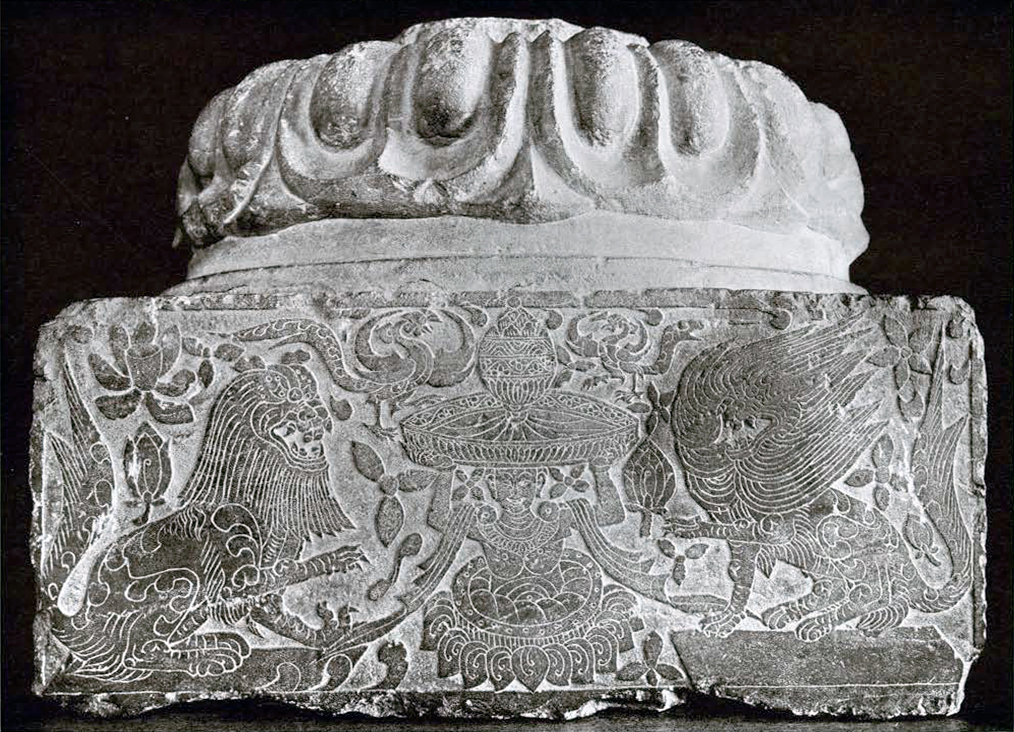
Museum Object Number: C145
Image Number: 1401
Passing now to the opposite face (Fig. 195), we find it occupied by an allegorical relief centered about a female figure, visible from the waist upward as it emerges from a lotus thalamus; above its head it holds a wide salver upon which stands an incense urn, upon the upper part of which appear conventionalized representations of mountains. In this half concealed female figure it seems probable that we have a most interesting example of the way in which the art of classic Greece has influenced that of the extreme east of Asia. The motive itself is a recognized and common one in Chinese Buddhist iconography. It appears twice, for example, on a stela now on exhibition in the University Museum (No. 13 in the Oriental Section), which was carved in 546, just twenty-two years later than the pedestal under discussion. The ancient Greco-Buddhist art of Gandhara, the region around the modern Peshawur, so well known to readers of Kipling, also has examples of this motive, and from them we learn that it is Sthāvarā, the Goddess of Earth, who is intended. The reference is to the Buddha’s struggle with the tempter, Mara, when the earth goddess, summoned to witness the triumph of the Master over the forces of evil, appeared out of the ground in the way depicted upon the pedestal. A step still further back brings us to the frieze surrounding the great altar of Zeus, at Pergamum, now in Berlin. Here, in the struggle between the Gods and the Giants, sons of Gaia, the latter is shown emerging from the earth she personifies, to intercede with Athena for the lives of her offspring. Just what the significance of the motive as introduced upon the pedestal may be, it is difficult to say; but that it had some connection, through the medium of Buddhism, with the classical art of the Mediterranean world there seems little doubt.
Flanking this central concept of the female figure and incense urn are a pair of Fêng-huang, or “phoenix birds,” as they are usually called by foreigners, and a lion and lioness. The latter, though far from true to life, are drawn with more accuracy than is always the case on Chinese monuments. The lion seems never to have existed in China, at least within the human period, and its introduction into Chinese art is due to Buddhist influence. Forced thus to depend for their conception of the animal upon second hand knowledge, it is no wonder that the Chinese artists went sadly astray in their efforts at its portrayal. It is amusing to read of the naïve astonishment of the envoy, Sung Yün, sent to India in 518 (just six years before the date of the pedestal) when he saw in that country living lions, and recorded that they did not look at all like the representations of them which he had seen in China. That a purely mythological concept such as the lion was to the Chinese of that day should become conventionalized and to a certain extent distorted was of course inevitable. Still it is rather surprising to find here the lioness equipped with a well developed mane which only differs from that of her mate in lying smooth and unruffled instead of bristling fiercely. The presence here of a lion and lioness instead of a pair of lions is of course an adumbration of the theory of the two principles, Yang and Yin (male and female, or positive and negative), upon which so much of Chinese philosophy is based.
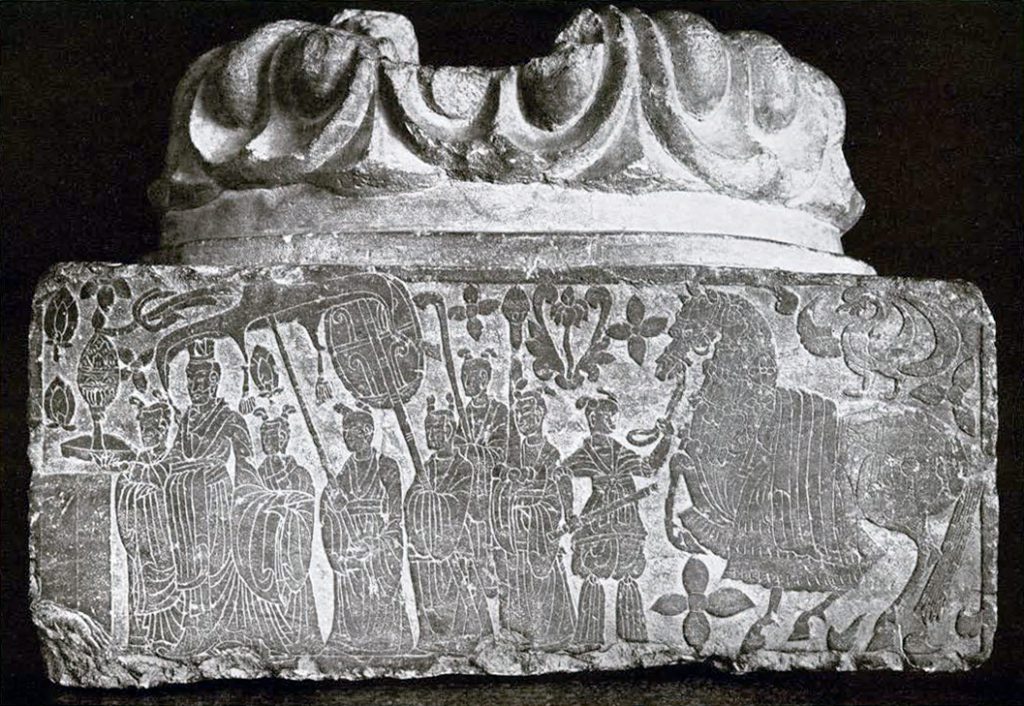
Museum Object Number: C145
Image Number: 1400
The Fêng, or “phoenix,” which by the way has no traceable connection with the mythical Arabian fowl which used to rejuvenate itself upon the altar of Heliopolis, belongs to the group of the Four Mythical Creatures, along with the Lung (dragon), the Kwei (fabulous tortoise), and the K’i-lin (unicorn). In early times the Fêng appears to have been conceived of as an eagle-like bird of colossal proportions, something like the roc of Sindbad the Sailor; but later it was described as having “the head of a pheasant, the beak of a swallow, the neck of a tortoise, and the outward semblance of a dragon.” In practice it is usually shown with the combined attributes of the peacock and the pheasant, embellished with gorgeous colors and with flame-like appendages where neck and body join. In his delightful book, “A Naturalist in Western China,” Mr. E.H. Wilson, after describing the Reeves Pheasant (Syrmaticus reevesi), says, “L’Abbé David suggests that this bird may be the original of the mythical Chinese Fung Hwang (Phoenix bird). To my mind this is extremely probable, but Williams in ‘The Middle Kingdom’ considers the Argus Pheasant, found in Tonking and southern Yunnan, the origin of this fabulous bird.” Whatever the origin of the concept may be, the Fêng has always formed a favorite motive in art, being looked upon as a bird of good omen, whose appearance heralds the advent of a beneficent ruler. According to the Chinese records it has never been seen on earth since the time of Confucius.
In the upper left hand corner of this face, surrounded by lotus petals, we see represented the sacred Pātra, the begging bowl of the Buddha, which has been aptly described as the Holy Grail of Buddhism. All blank spaces in the background of the design have been filled in with conventional floral designs, in which the lotus bud and blossom predominate. The effect thus produced has been compared to that of a piece of brocaded silk.
Turning now to the right hand face (Fig. 196), that to the north as the pedestal now stands, we find depicted a religious procession, in which the lead is taken by the donor of the monument. Wearing high headdress and flowing robes of state, and carrying in his outstretched right hand an incense urn similar to that shown on the front of the pedestal, he walks slowly forward, accompanied on either side by two youths, pages, or possibly sons, who seem to support his outstretched arms. Behind follow attendants bearing symbols of power and rank, such as a state umbrella, a banner screen, and batons. The rear of the procession is brought up by a groom who leads a spirited and magnificently caparisoned horse. The five conventionalized four petaled peonies shown on the animal’s neck indicate the rank of its master. The Fêng (“phoenix”) occurs again upon this face of the pedestal, and blank spaces are filled with floral ornament.
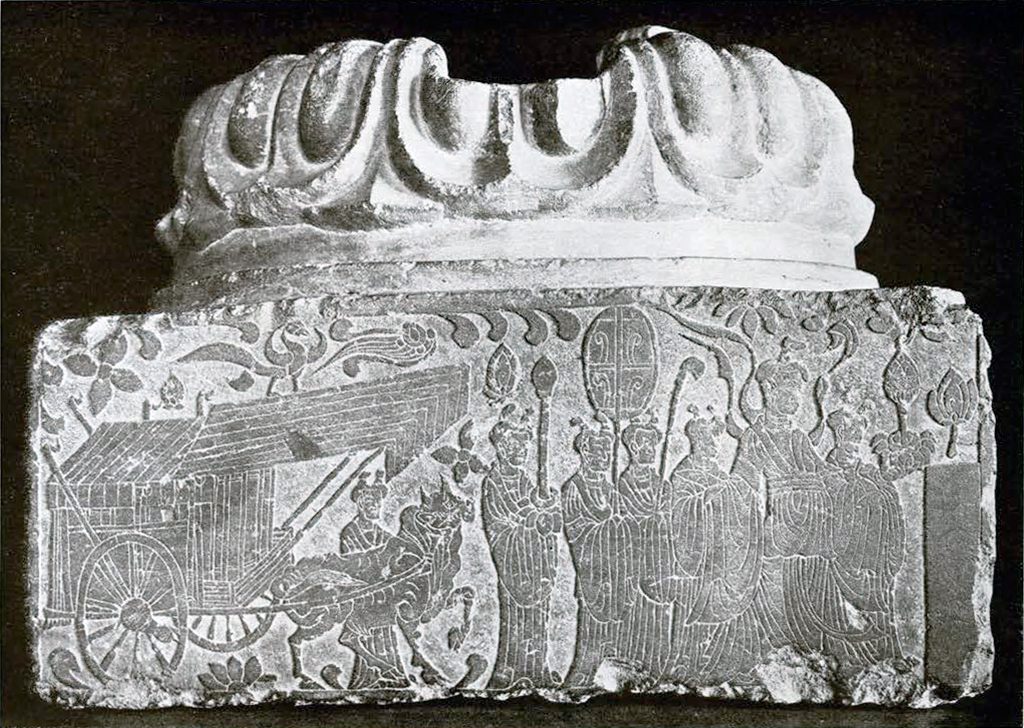
Museum Object Number: C145
Image Number: 1399
The opposite or left hand face (that to the south) displays a scene (Fig. 197), which is almost the counterpart of the one just described. Here, however, it is Madame Tsao, the wife of the donor, who heads the procession, bearing an incense burner exactly like that carried by her husband. She also is accompanied by attendants who support her outstretched arms or carry emblems of honor; the state umbrella borne over her husband, however, does not appear here, for that pertains not to the individual or the family, but to the office. Appropriately there is provided as a means of conveyance for the lady, instead of a saddle-horse, a two wheeled cart with canopy and curtains, drawn by an ox beside which walks a groom. Apart from its possession of a flat instead of an arched top, this vehicle is precisely like the modern Peking cart, although the use of an ox instead of a horse or a mule between the shafts recalls rather the Japanese usage in the drawing of state vehicles. The phoenix and floral decorations occur here also.
It would be difficult to overestimate the importance of this monument. Of unquestioned authenticity, exactly dated, displaying workmanship of a high order, and in almost perfect preservation, it enables us to form of the pictorial art of that distant time a truer conception than could be derived from any amount of written description or traditional evidence. It is not without reason that reproductions of the scenes depicted upon this pedestal are to be found in almost every book which has to do with the subject of Far Eastern art.
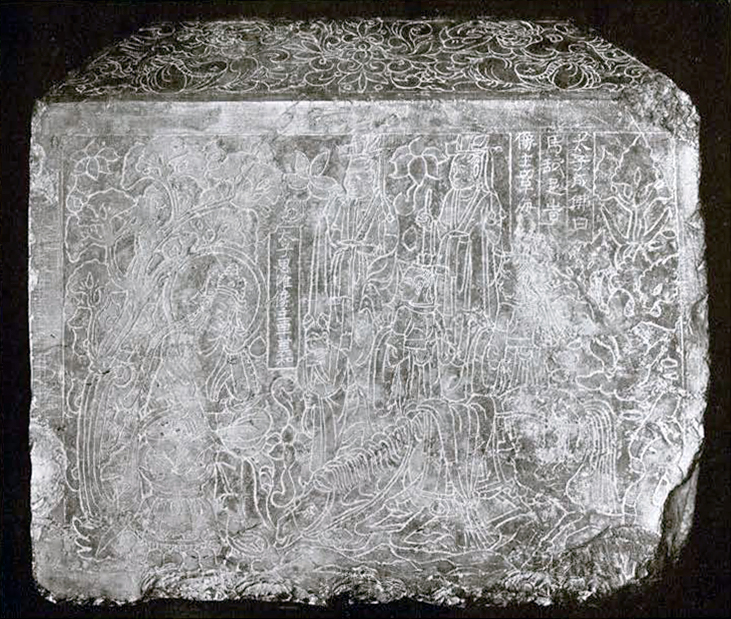
Museum Object Number: C144
Image Number: 1409
No less interesting is another pedestal. Probably of slightly later date than the one just described, it is also somewhat larger, measuring 33¾ inches by 21¾ inches, with a beveled top, and standing 20 inches high. A deep socket in its upper surface tells of the former existence of a stela, now lost. Upon its four faces are depicted not scenes connected with the dedication of the monument or having to do with the daily life of the period, but events in the career of the historical Buddha, Sākyamuni. The technique also differs somewhat, for the designs, instead of being rendered in low flat relief, are simply incised in the smooth surface of the stone, without any attempt to cut away the background.
The events depicted here are arranged in chronological order. The opening one (Fig. 198) is found on one of the shorter sides of the stone, that facing to the north as the pedestal is at present mounted. The accompanying inscription reads, “Kung Hai, donor of the image representing the crown prince at the moment when he became a Buddha, and when the white horse licked his feet.” The representation of the two events as occurring simultaneously involves a slight anachronism, inasmuch as seven years elapsed between the flight of Sākyamuni from his father’s house upon his white horse, Kanthaka, and his achievement of Buddhahood under the sacred Bōdhi tree, the “tree of illumination” (Ficus religiosa). The ascription of the title of “crown prince” to the Buddha is a result of the myth making tendency which exercised itself freely in the centuries succeeding the death of the great teacher. According to these myths, the father of the Buddha, Suddhōdana, was of the royal race of the Sākyas, over whom Sākyamuni himself would one day have ruled, had he not renounced his lofty position at the call of duty. Recent investigation, however, has made it pretty certain that the Sākyas had not as yet established the institution of the kingship as it was known in later times, but that they retained much of the freer, more democratic life of the Vedic period. They seem to have formed an aristocratic republic, whose affairs were administered by officers called rajahs, corresponding fairly well to the consuls of Rome or the archons of Athens. These Indian rajahs gradually succeeded, it is true, in extending their powers, until in later times they have come to be looked upon in the West as almost the type of the barbarically opulent Oriental monarch, wielding absolute power over the lives and fortunes of his subjects. This process had apparently commenced before the time of the Buddha (the sixth and fifth centuries B.C.), but it had not yet affected the Sākyas; and moreover the father of the Master was apparently not a rajah even in the sense in which the word was then understood.
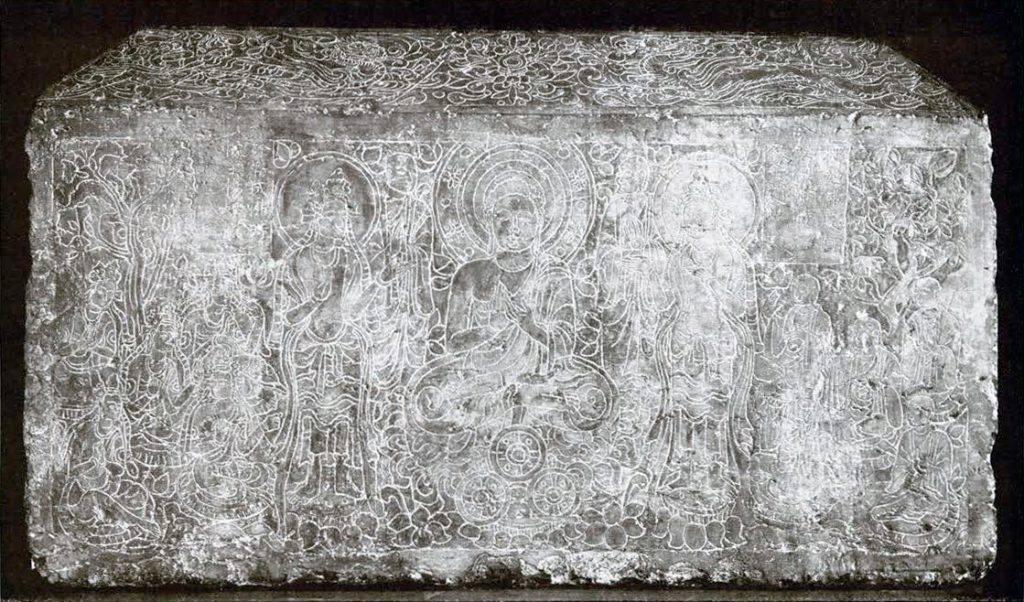
Museum Object Number: C144
Image Number: 1411
The five personages standing before the seated Buddha have no distinguishing attributes, although it may be that the one standing by the kneeling horse’s head, wearing a distressed expression upon his face, is the faithful groom, Chandaka, who assisted his young master in his flight, and is now bidding him farewell. At all events, this scene of the parting between Sākyamuni and his horse and groom is a favorite one in Buddhist iconography, and occurs wherever Buddhistic art remains are to be found today, from Afghanistan and the valley of the Indus to the islands of Japan. The white horse still plays an important part in Buddhist legend and story, and few who have visited Japan will fail to recall the sacred white horses kept in certain temple enclosures there. The Buddhists of course explain this custom on the ground that it was a white horse that carried Sākyamuni on his flight from his father’s house, and another that carried the first copies of the Buddhist scriptures from India to China (A.D. 67) and had the first temple in the latter country, the famous Pai Ma Ssu (lit. “White Horse Hall”), named for him in consequence. It seems more likely, however, that we have embodied here a belief that goes very far back of the beginnings of Buddhism, for a sacred character seems to have attached to white horses through the greater part of Asia and Europe from prehistoric times. The famous “Vale of the White Horse,” in Berkshire, and the white horses which drew the car of a triumphing Roman general (himself “made up” as Capitoline Jove) are instances in point, which might be multiplied almost indefinitely. That the ethical teachings of the Buddha were in large part original with him, at least in their application, may be conceded; but in the great body of legend and myth and tradition which gradually attached itself to the primitive doctrine, Buddhism finds itself linked up in a myriad ways with the folk tales and common beliefs that had spread themselves over a great part of the old Eurasiatic world ages before the dawn of history.
Sākyamuni himself, as he is depicted upon this face of the pedestal, is shown seated upon the lotus throne beneath the branches of the sacred Bōdhi (Bo) tree, in the attitude technically called that of “meditation.” The word has reference of course to the process by which he eventually achieved his self illumination and attained to the rank of a Buddha. Close beside is a cartouche with the words, “Kiu Han-ho, donor of the image showing the crown prince in meditation.” It will be noticed that the head of the Teacher is encircled with an aureole. This is strictly speaking an inaccuracy on the part of the sculptor, inasmuch as Sākyamuni during his period of meditation had not yet attained illumination, of which the aureole is a symbol. We must not look too closely, however, for an exact observance of the unities of time and place. Not only was the artist here trying to express a great deal in a limited space; but we must further bear in mind that Chinese pictorial art has always left much to the intelligence, or at least the imagination, of the observer, and has always endeavored to suggest rather than to depict exactly. In this particular case, for example, we see summarized all the leading events in the earthly career of the historic Buddha. His great renunciation, involving the relinquishing of father and wife and new born son, of wealth and power and social position, are suggested by the presence of the kneeling horse, which has just borne him on his flight from his ancestral home and is bidding him farewell. The sacred Bōdhi tree beneath which he sits, wrapt in profound meditation, recalls the long years of struggle and effort involved in his search for the truth. Lastly, the presence of the aureole brings to mind the successful outcome of that long struggle and the attainment of that bliss which, so taught the Master, lay within the reach of every living creature who willed to lead his life aright.
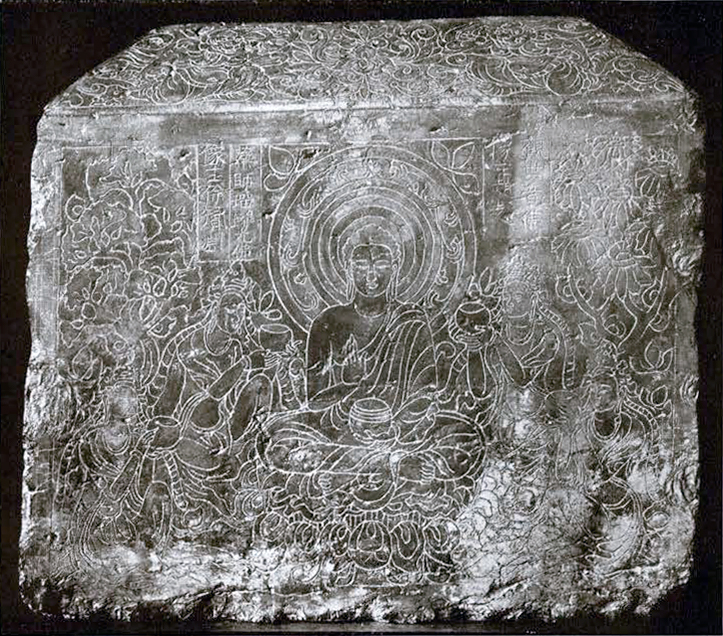
Museum Object Number: C144
Image Number: 1410
The next face (Fig. 199) of the pedestal, that to the east, shows the Buddha enthroned between two priests and two Bōdhisattvas, while below are three wheels. The Master is now evidently fairly launched upon his career as a religious teacher. Not only is this indicated by the presence of the three wheels, symbolizing the three principal occasions upon which he “turned the Wheel of the Law,” or in other words gave expression to .his doctrines; but he is here shown upon one of these occasions, the conversion of Ājnāta Kaundinya one of the most famous of his disciples. Here again the unities are disregarded, if indeed it ever occurred to the Chinese sculptor that there were such things. To the left of the Buddha are five high caste men in rich vestments, Kaundinya presumably among them, all listening to the new doctrine, while on the right, in the same scene, appear the same five, but now converted and with shaven heads and priestly garments. The trees at right and left represent the famous Deer Forest of Rsipatana. In the cartouche at the right are the words, “Ch’ao Hsi, donor of the image representing the Buddha Sākyamuni at the moment when he wrought the salvation of Ājnāta and when he put in motion all the Wheels (of the Law).” This evidently has a direct reference to the scene depicted here, Of the cartouche on the left, however, the same can not be said, for it merely mentions an individual who had given “an image of Māitrēya at the moment of becoming a Buddha.” No such event is shown anywhere upon this pedestal, and it seems reasonable to conjecture that this inscription, as well as certain others on the remaining faces, must refer to things depicted upon the stela which this block of stone once supported.
The beveled upper portion of this face shows two dragons flanking the sacred jewel Mani, one of the Sapta Ratna or Seven Precious Things, regarded in earlier times as a pearl, later as a diamond, and symbolic, in its manifold perfections, of the Buddha and his doctrines.
Turning now to the southern face (Fig. 200) we find portrayed a well-known scene in the (legendary) life of the Buddha, the presentation of the stone begging bowls by the four Dēvarājahs or heavenly kings. The story is that the Buddha could only accept such offerings as were placed in his begging bowl, the pātra, already noticed in connection with the preceding pedestal. Upon one occasion, when he found himself without a bowl, the four Dēvarājahs flew to his relief from the four quarters, each bearing as a gift a begging bowl of pure gold, which, however, the Master refused as unbecoming one so humble as himself. The four kings then offered successively bowls of less and less precious materials, until at last each of them placed before the Master a bowl of stone. The Buddha, unwilling to hurt the feelings of any of his faithful followers by refusing their gifts, accepted all four of the bowls. They proved, however, no encumbrance to him, for they straightway became one. In the carving the four bowls are shown separately, in the hands of their donors, who humbly extend them toward their Master, while he himself is represented as holding in his hand the miraculous fourfold bowl, whose multiple origin is indicated only by the four lines drawn about its rim. It is a very constant and apparently well founded tradition which represents Sākyamuni as always scrupulously careful of the feelings of those with whom he came in contact. This trait and his humanity toward animals are among the most attractive elements in the character of this wonderful man, as they are among the best authenticated.
The cartouches upon this face have no bearing whatever upon the scene with which they are associated, merely recording the names of donors of various images, no doubt among those shown upon the missing stela which once surmounted the pedestal.
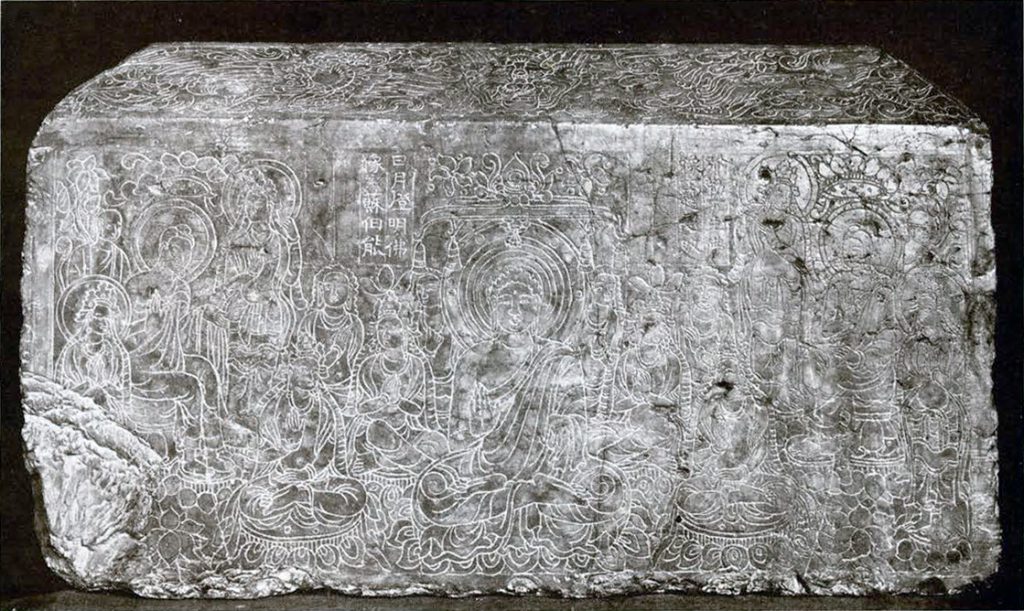
Museum Object Number: C144
Image Number: 1408
It is far less easy to identify the event represented upon the fourth face (Fig. 201) of this monument, that toward the west, for there is nothing quite so tangible to go on as is the case with the preceding scenes. It seems probable, however, that M. Foucher, the famous authority on Buddhist iconography, is correct in considering it a representation of that episode in the career of the Buddha known as “The Great Miracle of Crāvastī.” The story is to the effect that while holding a controversy with six heresiarchs before King Prasēnajit the Master confounded his adversaries by multiplying himself an infinite number of times in all directions. In pictorial representations of this proceeding (which it appears was most effective in silencing opposition) it is customary to show the likeness of the Buddha thrice repeated, and that is what has been done in this instance. The real Buddha is shown in the center, seated cross-legged upon a lotus throne in the robe of a monk, with an aureole about his head, and above him a canopy which supports the sacred jewel, Mani. Eight Bōdhisattvas are seated four by four to right and left in the same cross-legged attitude; two of them are partly concealed by the aureole, from behind which they seem to be peering. At right and left of the Bōdhisattvas again occur the two reduplications of the likeness of the Master, who here however is shown not cross-legged, but seated in European fashion. On either side of him stands an attendant Bōdhisattva, while behind him waits a monk, recognizable by his shaven poll. The cartouches have nothing to do with the scene here depicted, but as is the case with so many others they appear to refer to the lost stela.
Upon the beveled upper portion of this face are shown a Fêng (phoenix) and a K’i-lin or unicorn, flanking an ogre’s head mask. The K’i-lin, it may be remembered, is one of the Four Mythical Animals, and like the Fêng is considered a creature of good omen. The male of the species is named the k’i, while lin is the name of the female, the generic word for the creature being compounded of the two. It is said to have “the body of a deer, the tail of an ox, and a single horn.” This concept of a single horned deer-like animal seems to have arisen in India, although the existence of the rhinoceros in central China until far into the historical period may have played a part, just as that pachyderm undoubtedly had something to do with the shaping of the European belief in the unicorn, and just as, according to some, the alligator of the Yangtse had something to do with the origin of the notion of a dragon among the Chinese.
While it is true that none of the inscriptions upon this most interesting example of early Chinese sculpture gives any clew to its date, the style of the workmanship and particularly that of the written character enable us to place it confidently a century or two later than the pedestal described in the earlier portion of this paper, that is to say some time in the T’ang dynasty (618-907).
It would be difficult to find better examples than these two pedestals of the way in which the artistic impulse had permeated the whole Chinese nation at the period of their execution, an epoch which so far as Europe is concerned is commonly spoken of as the Dark Ages. Nothing is less likely than that they were the work of men of any particular standing as artists. They were the work of the stonemason rather than of the sculptor. Yet the composition is dignified, restrained, and perfectly balanced, and the scenes portrayed are chosen with the utmost appropriateness and good taste. It is a commonplace that no one has ever equaled the Chinese painter in the mastery of the line; but it is astonishing to find it handled with such vigor and confidence and feeling in so refractory a material as this very hard stone. From whatever point of view we consider these two relics of a great period in human history it is impossible to withhold our admiration, not merely for the technical skill of the execution, but also for the simplicity and sincerity and depth of the inspiration. Their importance from the standpoint of the archæologist and the historian of art it would also be difficult to overestimate.
C.W.B.
1 Bushell, Chinese Art, Vol. I., p. 36 and Pig. 22.
2 Chavannes, Ars Asiatica, Pt. II., pp. 30-33 and plates XLVI—XLIX.

